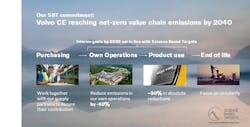Volvo CE Commits to Science-Based Targets with Approved Carbon Reduction Pathway
Volvo CE is continuing its long-time focus on environmental care and driving industry transformation to combat climate change with its commitment to science-based targets.
The target of net-zero value chain greenhouse gas emissions by 2040 is a united commitment for Volvo Group across all business areas, and is set for 10 years earlier than the SBTi (science-based targets) commitment. This is because Volvo products have an average lifetime of 10 years in the customer use-phase, so for the entire rolling fleet to have net-zero emissions by 2050, it is necessary that all products delivered after 2040 have net-zero emissions.
Volvo CE has also set its own high interim goals to be met by 2030, including cutting emissions in half in its own operations, facilities and manufacturing processes, and achieving 30 percent in absolute reductions in the use of its products, whose indirect emissions account for the highest proportion of the company’s carbon emissions. For the construction equipment industry, the majority of emissions are those referred to as indirect emissions, in other words the emissions created when the machines are being used as soon as they leave the factories.
“Climate change is real and one of the greatest challenges of our time,” said Volvo CE president Melker Jernberg. “As a world leading manufacturer, we not only have a responsibility to reduce our carbon footprint, we also have the clear vision, determination and talents to drive this transformation that is so urgently needed now. The choices we make today, will form the world tomorrow – and we choose to act.”
Volvo CE is already committed to decarbonization through its industry-leading technology development and engagement in climate change initiatives, such as the Construction Climate Challenge (CCC) and the WWF Climate Savers Program. With SBTi, it has another tool to make sure the reductions are aligned with the latest climate science to reach the Paris Agreement.
The company is taking a holistic approach to tackling climate change. It will follow its tried-and-tested innovation pathway of embracing the three streams of electromobility: battery-electric machines, hydrogen fuel-cell powered equipment and improved internal combustion engine solutions. It will also continue its work with industry-leading partnerships to accelerate development of new technologies, working together with customers to bring sustainable solutions to market and collaborating with dealers and suppliers to explore new ways of working.
“New exciting technology is definitely one of the key ways to reduce carbon impact,” said Niklas Nillroth, head of sustainability and public affairs at Volvo CE. “However, another significant driver in achieving these targets will be a new level of collaboration, internally as well as externally though partnerships. Only with joint efforts, where each and every one of us takes responsibility for our part with a holistic mindset, will we be able to collectively reach these important goals. Together we help build the world we want to live in.”
SBTi is a collaboration between CDP, United Nations Global Compact, World Resources Institute and World Wide Fund for Nature (WWF). It helps companies establish science-based targets to reduce greenhouse gas emissions and transform business operations to fit the future low-carbon economy.
About the Author
Michael Roth
Editor
Michael Roth has covered the equipment rental industry full time for RER since 1989 and has served as the magazine’s editor in chief since 1994. He has nearly 30 years experience as a professional journalist. Roth has visited hundreds of rental centers and industry manufacturers, written hundreds of feature stories for RER and thousands of news stories for the magazine and its electronic newsletter RER Reports. Roth has interviewed leading executives for most of the industry’s largest rental companies and manufacturers as well as hundreds of smaller independent companies. He has visited with and reported on rental companies and manufacturers in Europe, Central America and Asia as well as Mexico, Canada and the United States. Roth was co-founder of RER Reports, the industry’s first weekly newsletter, which began as a fax newsletter in 1996, and later became an online newsletter. Roth has spoken at conventions sponsored by the American Rental Association, Associated Equipment Distributors, California Rental Association and other industry events and has spoken before industry groups in several countries. He lives and works in Los Angeles when he’s not traveling to cover industry events.
